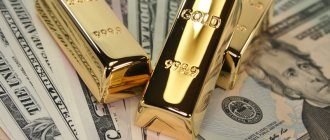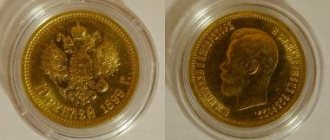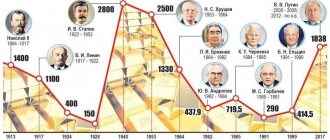Lazy Investor Blog > News
There is a lot of speculation in the media that the main cause of financial crises is the abandonment of the gold standard. The topic of returning to the previous system is also actively discussed. Let's see what is hidden behind this sonorous phrase, and how true are the postulates about its universality.
History of the gold standard
The gold standard is a system in which each banknote is backed by a fixed amount of precious metal. Its classical form allows that any person has the right to freely exchange banknotes for gold coins or bars. In such a situation, the government cannot print paper money in unlimited quantities.
The gold standard was first established in Great Britain in 1821. This allowed the pound to become the main reserve currency. Gold was chosen due to its unique characteristics:
- high cost of a small volume of metal;
- possibility of long-term storage without changing physical properties;
- easy divisibility and unification.
Gradually, all leading countries, including the United States, switched to such a system. But in its original form it existed for less than 100 years. Already during the First World War, European countries suspended the free conversion of banknotes into gold. In America, this happened in 1933, because the government needed to increase the money supply to recover from the Great Depression.
Attempts to return to the previous system after the situation had stabilized were unsuccessful. At first, the minimum exchange amount was limited: only those who were rich enough to buy a 12.5 kg bar could claim gold. Thanks to this, most of the money supply, which was in the hands of insufficiently wealthy people, was cut off from conversion.
Then the exchange for gold was stopped; instead, those who wanted to get rid of banknotes were given so-called. mottos. They were a means of payment and could be converted into metal.
In 1944, the Bretton Woods Agreement was concluded, which fixed a rigid exchange rate for the currencies of 44 countries relative to the American one, which, in turn, was tied to gold in the proportion of $35 per troy ounce. Already at this moment, many countries began to increase their dollar reserves, and the main world supply of gold was moved to the United States. Only central banks of other countries could exchange dollars for metal.
I also recommend reading:
Why, when oil becomes cheaper, gasoline becomes more expensive?
Why is gasoline not becoming cheaper in Russia?
The evolution of the global financial system is shown in the picture below.
Paper without gold
How the gold standard was achieved
Watch
— How, in this case, can we explain the fact of the rapid development of Russian industry and trade at the beginning of the 20th century after the reform of Witte, who introduced the gold standard of the tsarist ruble in 1897? Why will a “heavy ruble” now be detrimental to the economy?
— An expensive currency means a high interest rate on loans. That is, there is a demand for money, but the central bank will not be able to print new money, because it will be limited by the requirements of the gold standard. The world rests on the value of capital, no matter whether it is manufacturing or service. The development of any company comes through the introduction of new technologies, production, etc., but all this requires money, and attracting it is impossible if money is expensive. This is true for digital technologies as well. Take a company like Uber, for example: they went through periods when they weren't generating profits for shareholders and had to scrape by borrowing money. If money was very expensive, they couldn't borrow and Uber would disappear from the market. As for Witte’s gold ruble, at the time of the reform there were 1.1 billion in paper money in circulation in Tsarist Russia, and 1.095 billion in gold reserves, so the introduction of the gold standard did not lead to a limitation in money supply. Moreover, the ruble was not one hundred percent backed by gold. That is, for a certain time, the gold standard was effective, since it made emissions dependent on the universal equivalent - gold, and thereby sharply increased confidence in the ruble.
— From everything you say, it follows that with the return of the gold standard, the market would be cleared of ineffective and ill-conceived projects. Expensive money would force the world to abandon the habit of living in debt. What's bad?
— In practice, the world economy has been in debt for many hundreds of years! The first creditors in the history of mankind were temples, where people took their capital for safety (temples were not robbed). The guardians of the temples began to lend this money. Over the centuries, the function of money has remained unchanged: it is still a universal commodity that can be used to pay for anything and everything. This is more convenient than in-kind exchange. In addition, money allows you to create capital: it can be accumulated and invested. Today you can take out loans from banks, place money in bonds, shares, and raise funds. With the development of the financial market, a need arose to reduce risks, and financial instruments were created to protect investments from risks (insurance, secondary market). But if you return to the gold standard and artificially limit the amount of money in the economy, this is bad.
The 1998 domestic debt default in Russia was largely due to the fact that the Russian economy was categorically short of money. And what did the enterprises do? Mutual offsets and in-kind exchange. Gold mining is limited in volume and is not cheap. If it were possible to increase the reserves of this metal every year at the rate required by the economy, at least by 10–15 percent... And even better, to ensure that there was more gold than money in the economy, this would make it possible to increase emissions under the gold standard. But this situation is unrealistic, since world gold production is not growing at such a pace. This means that the world will always experience a shortage of gold, which means that when a gold standard is introduced, “emergency exits” will be quickly found for the emerging framework. I'm talking about the development of alternative currencies, including private ones.
Abolition of the gold standard
In August 1971, US President Nixon announced that the exchange of dollars for gold would cease. The reason given was the discrepancy between the actual purchasing power of the American currency and the stated exchange rate relative to gold.
In parallel, he took a number of political actions that allowed the dollar to become the most popular unit of payment in the world. First of all, this was achieved through an agreement with Saudi Arabia on the sale of oil only for American money. In fact, a system was formed that was called the petrodollar. Subsequently, other producing countries joined this rule.
The trend was not reversed even in 1973–75, when, due to the military conflict in the Middle East, members of the OPEC cartel stopped supplying hydrocarbons to those who supported Israel. It was the oil crisis, and not the refusal to exchange dollars for gold, that then dealt a blow to the S&P 500 quotes. It lost half of its maximum and recovered only by 1983.
In subsequent years, the dollar issue was unlimited. This led to its devaluation relative to gold. The price per ounce increased from $35 in 1971 to $42 in 1973 and to $850 10 years later. A direct consequence of Nixon's actions was the rupture of the Bretton Woods Agreement and the transition to the Jamaican system, under which countries can choose their own exchange rate regime: floating, fixed or mixed.
“...And not an ounce of gold”: how the United States ended the Bretton Woods agreement
When the treasury was empty, he ordered
collect common shells
and ordered them to be considered money.
— Historical
Alexander Vinogradov: “Today, August 15, 2021, is a special anniversary. A decision that is fundamental to the current world monetary system is celebrating its half-century.” Photo courtesy of Alexander Vinogradov
The history of the Bretton Woods agreement is well known and well documented.
Today, August 15, 2021, is a special anniversary. This is the half-century anniversary of a decision that is fundamental to the current world monetary system. It was very risky, since no one could initially predict its consequences. At the same time, it was ripe and overripe: delay threatened the disintegration of the entire existing system of international trade. Yes, we are talking about the very cancellation of the possibility of exchanging dollars for gold at a fixed rate of $35 per ounce, which de facto ended the Bretton Woods agreement. This decision was made by then US President Richard Nixon . Gold has ceased to be a support for the dollar, having turned into another type of raw material, but this does not stop the dollar from being the main world currency.
The history of the Bretton Woods agreement is well known and well documented. In July 1944, representatives of 44 countries of the anti-Hitler military coalition arrived in the town of Bretton Woods for a conference, the purpose of which was declared from the very beginning: to negotiate the format of the post-war world monetary system. This was done: gold was fixed in price at $35 per troy ounce, the dollar is thus taken as the main currency, and the rates of other currencies are fixed to it with permissible small fluctuations. It was assumed that if they go beyond this amplitude, then the local Central Bank undertakes to intervene, and in special cases controlled revaluation and devaluation are allowed. Finally, an agreement was reached to create the IMF and the IBRD (Bank for Reconstruction and Development), two key institutions whose purpose was to keep the entire system running.
The reason for these decisions, in general, was also clear. At that time, it was already obvious to economists that the monetary system based on gold as a physical carrier of value had outlived its usefulness. This was due to the physical shortage of gold to ensure sufficient monetization of the economy, which directly led to deflation and hoarding (saving money rather than putting it into circulation). This factor is a severe brake on economic growth and, more broadly, economic activity - and it was necessary to move away from gold as a means of payment. At the same time, it certainly remained as support for the new system based on the dollar. Again, it’s clear why it is here: the country is not destroyed after the war, the economy is strong, capital reserves are large. Strictly speaking, there was nothing else to rely on; the British pound sterling was clearly no longer suited to the role of such a supporting currency.
The new rules turned out to be very convenient for countries that were recovering after the war
The process has begun. The new rules turned out to be very convenient for countries that were recovering after the war, and it was in no way similar to the interwar chaos with completely different mechanisms, when countries either abolished the gold standard, then restored it again and, in general, pursued radically different policies. Essentially, uniform rules of global trade have emerged - beneficial for the whole world. Of course, except for the Soviet bloc, which existed independently, and, suddenly, the United States itself - more on that below.
The post-war period is literally filled with what was later called the “economic miracle”. German is widely known and is usually associated with the firm and wise leadership of Chancellor Konrad Adenauer and Economics Minister Ludwig Erhard . That’s how it is - but in parallel with the German one, there was also an Italian “miracle”, although there was a traditional leapfrog with governments, the Greek one (a similar situation), the French one, the Japanese one, and so on. All this was a typical example of investment interaction between a developed country and developing countries. The United States opened its sales market and offered investments; war-torn countries willingly accepted them, rebuilt enterprises and sold cheaper goods to the rich American market.
The dollar was the reserve currency for this entire system, but over time the weaknesses of the agreements reached were revealed. The main one was that this practice created a constant foreign trade deficit for the United States; the country imported more than it exported. There were more and more dollars in the world (outside the US borders), and the rate of growth of this mass of money was higher than the rate of replenishment of gold reserves - to which, let me remind you, the dollar was rigidly tied. Thus, if in 1955 American gold reserves were approximately twice as large as the dollars accumulated abroad in the reserves of central banks, then by 1971, the time of Nixon’s decision, American gold could cover only about a quarter of the green dollars circulating around the world.
In addition, problems began in the United States itself. Cheap imports and expensive exports mean job losses: the American consumer (who has money) buys an imported product, causing the American manufacturer to go out of business. Unemployment went up, and active printing of dollars also affected inflation. In fact, the United States faced the full problem of losing its economic leadership: other countries could play with the exchange rates of their currencies in any way they wanted (devaluation, supposed to be a “special” tool, quickly became a habit as a simple aid in the competition for the market), but the United States , “fastened” to gold and $35 per ounce, could not afford this. Even worse, politics intervened: at some point, relations between the United States and France deteriorated, and in early August 1971, France sent a ship full of green pieces of paper to the United States, demanding that they be exchanged for yellow metal. A little later, Great Britain made a similar demand. Richard Nixon had no choice but to turn over the chessboard - which was done.
Money is what people massively consider money
This decision was revolutionary, and the reaction of observers was appropriate. Many people expected a “hard landing” of the US economy, a collapse of world trade, and the end of the “dollar empire” - but all this did not happen, even against the backdrop of a sharp rise in oil prices in the 70s. The dollar turned out to be convenient in calculations because a quarter of a century of using it as a standard established it as such de facto; someone who has a dollar could give it to anyone for any product, because the recipient of this dollar could give it further by buying what he needed . It suddenly became clear that this kind of activity does not require a strict link to gold reserves at all and that the system works quite well on its own.
There are only two questions left: how much of that same dollar is needed at each moment of time, how to calculate it, why exactly. The second was a little different: what to do with the fact that the dollar is issued not only by the regulator (the US Federal Reserve), but also by banks (through fractional reserves) and that more and more settlements went into the financial system without using the physical embodiment of capital? There has been and remains a lot of debate on this topic, but in the meantime the Fed is doing its job by monitoring the level of inflation and regulating the rate and reserve ratio - and through this (of course, not counting various kinds of “emergency” emission programs) managing the supply of dollars. And on the whole it works: in fact, by abandoning expensive physical media, the world economy received a tool for building a correspondence between the needs of trade and the market - and the reserves of “zero-price-of-production” money that meets these needs.
The new world, without the dollar being pegged to gold, was secured in 1976 by agreements known as the Jamaica Monetary System. Its main postulates are simple: floating exchange rates between currencies, and gold is an important traded commodity, but nothing more. Of course, it is not forbidden to store it in reserves, which many do, but formally such storage is no different, for example, from storing the same oil. Although, of course, traditions dictate the storage of gold in reserves.
This is a very interesting evolution of money: from the value “in itself” (a gold coin) to a derivative that is cheap to create (a banknote backed by this gold coin not in a 1:1 ratio) and then, most likely, to zero in the creation of an ephemeral substance ( digital currency, and a state one) with the greatest possible ease of use.
Simply put, money is what people massively consider money. In other words, money is backed only and exclusively by trust: that you can always buy what you need for it, that the regulator guarantees the preservation of property, that there will be no sharp changes in the money supply and, accordingly, a decrease in the size of accumulated capital, that transaction costs in the system are low and that the market is capacious - and the sale of anything will not disrupt the dynamic balance of supply and demand.
Pros and cons of ending the gold standard
The consequences of the abolition of the gold standard can be divided into positive and negative.
Minuses
The result of the abolition of the gold standard was inflation. As governments of all countries began to print national currencies on an almost unlimited scale, the purchasing power of money decreased dramatically. There was an opportunity to inflate bubbles and currency speculation. This also led to an increase in the volume of debt obligations. Newly issued banknotes came into circulation through the credit system.
Another negative aspect of the abolition of the gold standard was the breakdown in the correlation between real wages and labor productivity growth. Even if nominal income increased, it did not keep pace with the rate of inflation. This has led to a slowdown in people's quality of life.
With the refusal to back national currencies with gold, the stability of the economy decreased. If a state collapses, the money it issued is completely worthless. It is no longer possible to predict the lower limit of economic decline in the event of a crisis.
I also recommend reading:
Who is Chichvarkin, and can he be called an investor?
Business and investment according to Chichvarkin: not suitable for everyone
pros
However, there were also positive aspects to the abolition of the gold standard. First of all, this is the acceleration of economic growth. It was the ability to issue the money supply without restrictions and quickly increase liquidity that made it possible to overcome the Great Depression at one time. These same actions helped smooth out all subsequent crises.
A strict link between the volume of money supply in circulation and the amount of gold accumulated by central banks leads to the fact that production growth provokes deflation. This process, in turn, forces the production of new products to be reduced and workers to be laid off. The refusal to link banknotes to precious metals made it possible to reverse this situation.
The second positive side of abandoning the gold standard was the opportunity to pursue a flexible financial policy. Thanks to this step, central banks can quickly change the value of national currencies. This allows the use of controlled devaluation to reduce the risk of default. It is also used to increase the competitiveness of domestic producers.
How the end of the dollar's gold backing changed the world
The essence of the change provoked by the American authorities is an audit - no more nor less - of the nature of money. For five thousand years, they were objects that had intrinsic and universally recognized value, mainly precious metals. Any modifications to financial systems came down to differences in the mechanism for exchanging symbolic symbols for “real” money. And only half a century ago it was said that in the new world there is no longer and will not be any “real” money. The banknotes of our time are debt receipts - similar to those that appeared in Europe more than five hundred years ago - but no longer from private banks, but from state ones. By accepting the dollar as taxes, the American state supported the demand for it, which was enhanced by the fact that this currency remained “its own” in the world’s largest market and for almost a quarter of a century until 1971 was the only one accepted everywhere in the world as freely exchangeable for gold.
Of course, the abandonment of the gold backing of the dollar caused a large-scale crisis. Oil exporters demanded price indexation in proportion to the increase in gold prices. The price of oil increased 6.5 times from 1971 to 1974 and another 3.2 times from 1974 to 1980. This shock ended 30 years of post-war prosperity for the Western world. Inflation spiraled out of control, and the Federal Reserve's discount rate reached an unprecedented 20% per annum in March 1981.
However, the difficult period is over, and America emerged from it seriously strengthened. High rates ensured an influx of capital, and a cheap dollar added competitiveness. The technological revolution has reduced the need for resources. Declining prices for raw materials in the 1980s bankrupted half of the countries of Latin America, and then the USSR. But developed countries received an unprecedented instrument of state support for the economy: by borrowing in dollars - that is, in their own currency, not tied to any equivalent, the Americans eliminated the division of debt into internal and external, and at the same time forgot about foreign trade. Due to the growth of public debt, the United States could overcome any economic crisis, which was visibly demonstrated first in 2008, and to an even greater extent in 2020.
Today, if you compare the US economy in 1950 and 1985. both in 1985 and 2021, one can understand the scale of change. The gross product in the first case increased by 3.5 times, in the second - by 2.6 times, and stock indices soared by 9 and 23 times, respectively. The new quality of money led to the emergence of new payment systems, and the financial sector became the main consumer of information technology. Huge “bubbles” in stock markets turned into a kind of airbag: each new crisis affected the real sector less and less, and its consequences were forgotten more and more quickly. After the Great Depression, the US stock market took 23 years to recover, after the crash of 1973 - 8 years, after the crisis of 2008 - 6 years, in 2020 - only 7 months.
The potentially unlimited supply of money and its transformation from some objective value into an instrument of public policy largely ended its history as a scarce resource. After 2008, zero interest rates became commonplace, and nearly 27% of high-quality bonds were delivering negative returns at the end of 2021. In 2000, the United States allocated 12.3% of budget expenditures to service its debt (then it amounted to 55% of GDP), and in 2020 (when the debt rose to 129% of GDP) - only 5.22%. In the future, this figure will decrease further until it eventually approaches zero.
The events of the past year heralded the final arrival of a new era. If before this, government debt could be sold to investors at competitive auctions, then almost all of the “pandemic” debt was purchased by the American Central Bank - the Federal Reserve System: government debt in 2021 grew by $4.16 trillion, and the Fed’s balance sheet grew by $3.19 trillion Most of the Fed's revenue is returned to the budget the following year, so the real cost of servicing the debt is even less than it seems. However, this is not the most interesting thing. By increasing the debt by an astronomical amount equal to 20% of GDP, the American authorities provoked a flow of money into asset markets - as a result, from the lowest point of decline in April 2021, the stock market added $13.4 trillion by August 1, 2021 - 3.3 times more than the government borrowed. For the first time in history, increasing debt led to explosive growth in wealth. In the era of “real” money, such alchemy was simply unthinkable.
Despite the fact that the economies of developed countries today are developing according to new laws (Europe also followed the path of America, creating its own single currency at the turn of the century, and introducing a zero-rate policy in the mid-2010s), it is not becoming less stable. Inflation, as a result of huge injections, grew non-catastrophically (in the United States in the second quarter of this year it amounted to 4.5% in annual terms, in the euro area - 1.9%); stock markets soar to new heights; Pension fund assets are growing, real estate is becoming more expensive.
Over the past half century, the world has been divided into two parts: one in which government spending is determined by need, and one where it is limited by opportunity. In the first six months of the pandemic, the United States increased its debt by more than China has accumulated in reserves over the past 25 years. To put the numbers into perspective, in the 12 months since the pandemic began, the United States has injected funds equal to the entire Russian National Wealth Fund into its economy every two weeks. What clouds do you need to be in to talk about a possible victory for China in the economic confrontation with the West?
I am deeply convinced that most modern economists and politicians still do not understand what consequences the financial revolution that began fifty years ago brought to the world. New opportunities, in fact, have eliminated the very concept of scarcity: if necessary, the volume of material production can be increased by 1.5–2 times in three to five years on a global scale. The main limiting factor has always been demand, and it is this limitation that is now beginning to be eliminated. However, all of the above applies only to those economies that are sufficiently flexible and at the same time have the ability to issue major currencies - because in any other open financial system, an increase in public debt and emissions will only lead to an increase in demand for a more reliable asset, a depreciation and inflation with all that it entails consequences.
The notorious dedollarization today is a flight from the most liquid and profitable asset to very unreliable and non-universal ones. Stories that the share of the dollar in the reserves of the world's central banks is declining is a psychotherapy session for losers, since the real central banks of the modern world, the Fed and the ECB, have no reserves at all. Judge for yourself: the US gold reserve at current market value is equal to 6.5% of the Fed’s balance sheet, the ECB’s reserves amount to about 1% of its total assets, while the gold and foreign exchange reserves of the Bank of Russia are equal to 60% of its balance sheet, but at the same time, the ruble has depreciated three times in 15 years to the dollar and euro, and not vice versa.
Shocks 2020–2021 only confirm the scale of previously launched changes. In Russia, where authorities pride themselves on pursuing “tough” fiscal policies, vegetable prices have risen by more than 30% over the past six months, and in the US and Europe, where government debt has risen by 20–25% of GDP over the past year, they practically didn't move. Therefore, instead of talking about the “inevitable end of dollar hegemony,” it is worth carefully analyzing the risks that exist for Russia in the new world economy and soberly assessing the opportunities we have.
In 1971, the United States carried out a hidden devaluation - they de facto devalued the dollars held by foreign holders, and then started inflation in their own country. In 2021, America can achieve the same result in a much less “dark” way: it has the opportunity not to devalue other people’s money, but to multiply its own. No one will refuse to accept dollars or redeem Treasury bonds: they can always be paid for from a new issue. It's just that most of the world will redistribute wealth over the coming decades, while developed countries will create it.
Of course, this system will not be eternal, just as nothing is eternal either in the economy or in society as a whole. However, it is becoming increasingly clear that the past half century was not a period of painful dying of the old system, which was about to collapse, but a time of the formation of a new one, which is just getting ready to show its mettle. And this means that we need to adapt to a world that we, of course, are capable of destroying, but, alas, cannot change...
Risks and prospects of the modern monetary system
The main risk of a monetary unit that does not have a strong anchor in the form of gold remains the possibility of rapid depreciation. At the global level, the currency risk of exporters and importers plays a key role. It is due to free exchange rates, which can change quickly relative to each other. In addition, excessive issuance leads to the fact that profits in the market are redistributed in favor of the financial sector. Manufacturers account for a smaller part of it.
However, such a prospect for the development of the world monetary system as a return to the gold standard seems impossible today. This is explained, first of all, by the lack of gold reserves. The following scenarios are more likely:
- the formation of new transnational currencies similar to the euro;
- the emergence in the distant future of a global payment unit;
- an increase in the number of global reserve currencies;
- the prospect of switching to digital money, for example, in the form of cryptocurrencies.
I also recommend reading:
How the RAMM copy trading service from the broker AMarkets is developing
RAMM service instead of PAMM: how is the new product doing?
Academician Abel Aganbegyan on the protracted stagnation in which Russia is stuck
In this sense, the stability and predictability of the dollar is much higher than that of gold. But that's just one problem. The second is that gold is not a very liquid commodity, that is, you cannot enter the market with large volumes of gold, otherwise there is a risk of a price collapse. In other words, gold is an acceptable “defensive” asset, but its size when forming various types of reserve funds is limited to 10–15 percent of the total reserves. The rest consists of securities, shares, bonds of private and government issuers. Investing more than 10-15 percent in gold is considered unprofitable in terms of liquidity, profitability and volatility of the asset.
— Maybe these standards are outdated? Russian reserves already consist of almost 20 percent of gold, and on March 29, changes to the Basel III standard came into force and gold was returned to its monetary status. Since then it has only grown in price...
— The Basel process is an institution within which central banks of different countries develop supervisory standards for banks. They cannot make any categorical decisions, only recommendations. Whether countries follow it or not is their business.
— So you don’t believe in the return of the gold standard?
- No, this is impossible in principle. The world economy has come so far in the half century since its abolition that going back will be fraught with serious financial problems. The gold standard is an extremely inflexible financial system for a modern economy for the reason that gold production is growing at a much lower rate than the demand for money: 2-3 percent per year versus 10-15 percent, and the cost of production is high.
If we adhere to the gold standard, then the monetary policy of such a central bank will hinder economic growth.
There is not enough money in the economy, which means that the cost of credit is prohibitive, and there is no launch of new industries or services.











